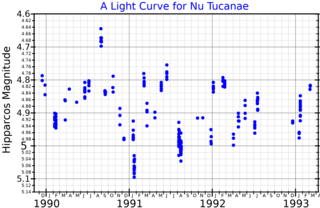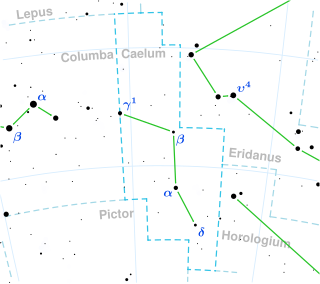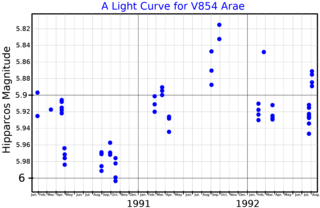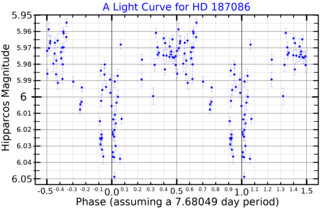
ν Tucanae, Latinized as Nu Tucanae, is a solitary, variable star in the southern constellation of Tucana. This red-hued object is visible to the naked eye as a faint star with an apparent visual magnitude that fluctuates around +4.80. It is located approximately 290 light years from the Sun based on parallax, but is drifting closer with a radial velocity of −3 km/s.

3 Aquarii is a variable star in the equatorial constellation of Aquarius. 3 Aquarii is the Flamsteed designation; it also bears the Bayer designation k Aquarii and the variable star designation EN Aquarii. With a mean apparent visual magnitude of 4.429, it is visible to the naked eye in dark skies. It has an annual parallax shift of 5.57 milliarcseconds with a 5% margin of error, which translates to a physical distance of around 590 light-years from Earth.

RV Caeli, also known as HD 28552, is a solitary, red hued variable star located in the southern constellation Caelum, the chisel. It has an apparent magnitude of 6.4, placing it near the limit for naked eye visibility. The object is located relatively far at a distance of 1,340 light years based on parallax measurements from Gaia DR3, but is rapidly receding with a heliocentric radial velocity of 98 km/s.

LN Andromedae, also known as HD 217811, HR 8768, is a formerly suspected variable star in the constellation Andromeda. Located approximately 458 parsecs (1,490 ly) away from Earth, it shines with an apparent visual magnitude 6.41, thus it can be seen by the naked eye under very favourable conditions. Its spectral classification is B2V, meaning that it's a hot main sequence star, emitting light approximately with a blackbody spectrum at an effective temperature of 18,090 K.

NO Apodis is a solitary, red hued variable star located in the southern circumpolar constellation Apus. It has an average apparent magnitude of 5.86, allowing it to be faintly seen with the naked eye. The object is relatively far at a distance of 790 light years but is drifting closer with a heliocentric radial velocity −18.3 km/s.
HD 161988, also known as HR 6635, is a solitary, orange hued star located in the southern circumpolar constellation Apus. It has an apparent magnitude of 6.07, allowing it to be faintly visible to the naked eye. Parallax measurements place it at a distance of 621 light years, and it is currently receding with a heliocentric radial velocity of 36.8 km/s.

HD 155035 is the Henry Draper Catalogue designation for a star in the constellation Ara, the Altar. It is located at a distance of approximately 1,450 light-years from Earth and has an apparent visual magnitude of 5.92, making it is faintly visible to the naked eye. This is a red giant star with a stellar classification of M1.5 III. It an irregular variable that changes brightness over an amplitude range of 0.12 magnitudes.

HD 128333 or CH Boötis is an irregular variable star in the northern constellation of Boötes. It is currently on the asymptotic giant branch of the HR diagram.

CQ Camelopardalis, abbreviated as CQ Cam, is a solitary variable star in the northern circumpolar constellation Camelopardalis. It has an apparent magnitude of 5.19, making it visible to the naked eye under ideal conditions. The object is relatively far at a distance of about 2,000 light years but is drifting closer with a helicoentric radial velocity of −22 km/s. It has a peculiar velocity of 21.8+2.1
−1.9 km/s, making it a runaway star.

HD 27245, also known as HR 1335 or rarely 25 H. Camelopardalis is a solitary red-hued star located in the northern circumpolar constellation Camelopardalis. It has an apparent magnitude of 5.4, making it faintly visible to the naked eye. Gaia DR3 Parallax measurements place it approximately 607 light years away from it the Solar System and is drifting further away with a heliocentric radial velocity of 25.2 km/s. At its current distance, HD 27245's brightness is diminished by 0.36 magnitudes due to extinction from interstellar dust. It has an absolute magnitude of −0.27.
HD 85951, formally named Felis, is a solitary orange hued star in the constellation Hydra. It has an apparent magnitude of 4.94, making it faintly visible to the naked eye under ideal conditions. Based on parallax measurements, the object is about 570 light-years away from the Sun and is receding with a heliocentric radial velocity of 50 km/s.

HD 44131 is a star in the equatorial constellation of Orion, positioned near the eastern constellation border with Monoceros. It has a reddish hue and is faintly visible to the naked eye with an apparent visual magnitude of 4.91. The star is located at a distance of approximately 465 light years from the Sun based on parallax, and it is drifting further away with a radial velocity of +48.6 km/s. Based on radial velocity variations, it is a candidate spectroscopic binary system and a preliminary orbital solution was published in 1991 with a period of 9.29 yr. However, these velocity variations may be due to other causes.

Chi Pegasi, Latinised from χ Pegasi, is a single star in the northern constellation of Pegasus, along the eastern constellation border with Pisces. It has a reddish hue and is faintly visible to the naked eye with an apparent visual magnitude of 4.80. The distance to this star is approximately 368 light-years based on parallax, but it is drifting closer with a radial velocity of −46 km/s.

1 Puppis is a single star in the southern constellation of Puppis. It lies in the northern part of the constellation at a distance of about 790 ly, east of Aludra in Canis Major and just north of the white supergiant, 3 Puppis. This object is visible to the naked eye as a faint, red-hued star with an apparent visual magnitude of 4.59. It is moving further from the Earth with a heliocentric radial velocity of +32.4 km/s.

Y Centauri or Y Cen is a semiregular variable star in the constellation of Centaurus.
HD 133981, also known as HR 5628, is a solitary, bluish-white hued star located in the southern circumpolar constellation of Apus. It has an apparent magnitude of 6.02, allowing it to be faintly visible to the naked eye in ideal conditions. The object is located relatively far at a distance of 856 light years based on parallax measurements from Gaia DR3 but is approaching the Solar System with a heliocentric radial velocity of −13.7 km/s.
HD 1032 is a solitary star in the southern circumpolar constellation Octans. It is faintly visible to the naked eye with an apparent magnitude of 5.77 and is estimated to be 850 light years away from the Solar System based on parallax measure. However, it is receding with a heliocentric radial velocity of 4 km/s.
HD 193373 is a solitary red hued star located in the equatorial constellation Delphinus. It has an apparent magnitude of 6.21, placing it near the limit for naked eye visibility. Parallax measurements place it 846 light years distant and it is currently receding with a heliocentric radial velocity of 22.7 km/s.

8 Leonis Minoris is a solitary, red hued star located in the northern constellation Leo Minor. It has an apparent magnitude 5.37, making it faintly visible to the naked eye. Based on parallax measurements from the Gaia satellite, the object is estimated to be 492 light years distant. It is receding with a heliocentric radial velocity of 40 km/s. At its current distance, 8 LMi is diminshed by 0.12 magnitudes due to interstellar dust.

HD 187086, also known as HR 7537, is a probable astrometric binary located in the southern constellation Telescopium. It has an average apparent magnitude of 5.9, making it faintly visible to the naked eye. The star is located relatively far at a distance of 1,020 light years based on Gaia DR3 parallax measurements but is rapidly drifting closer with a heliocentric radial velocity of −64 km/s. At its current distance, HD 187086's brightness is diminished by 0.27 magnitudes due to interstellar dust. It has an absolute magnitude of −0.8.















